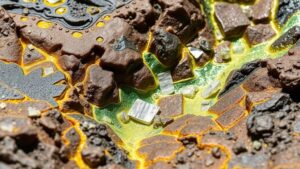Techniques for Recovering Silver From Weathered Outcrop Zones
Techniques for Recovering Silver From Weathered Outcrop Zones
Silver, a precious metal prized for its conductivity and aesthetic appeal, is often found in weathered outcrop zones. These zones, exposed to atmospheric conditions, present unique challenges and opportunities for mineral recovery. This article delves into the various techniques employed to extract silver from these naturally weathered environments, highlighting their effectiveness and real-world applications.
Understanding Weathered Outcrop Zones
Weathered outcrop zones are surface areas where geological formations have undergone significant physical and chemical change due to environmental factors. This weathering can result in the liberation of silver-bearing minerals, making them accessible for extraction. The primary types of silver ores found in these zones include:
- Argentite (Ag2S): A primary silver sulfide mineral commonly found in weathered deposits.
- Native Silver (Ag): Rarely found in its pure state, but can occur in enriched weathered zones.
Efficient recovery of silver from these outcrops requires understanding the geology and chemistry behind these weathered materials.
Techniques for Silver Recovery
1. Physical Separation Techniques
Physical methods utilize differences in physical properties such as size, shape, and density to separate valuable minerals from gangue materials. Techniques include:
- Panning: A simple yet effective technique employed in small-scale mining, where a pan is used to separate heavier silver particles from lighter materials.
- Gravity Concentration: Utilizing shaking tables and jigs to exploit density differences between silver minerals and host rock can increase recovery rates significantly.
For example, in the Klondike region, miners historically used panning as an efficient way to extract native silver from weathered outcrops, achieving recoveries of over 90% in select areas.
2. Chemical Extraction Methods
Chemical methods can be particularly effective in recovering silver, especially from low-concentration ores. Two notable processes include:
- Cyanidation: This process involves the use of cyanide to dissolve silver and other metals from ores. solution is then treated to precipitate the silver.
- Thiosulfate Lixiviation: An alternative to cyanidation, this method uses thiosulfate ions, which are less toxic than cyanide and can be equally effective in extracting silver from sulfide ores.
In recent studies, such as those conducted in Northern Ontario, cyanidation has demonstrated silver recoveries of up to 95%, illustrating its effectiveness even on weathered materials.
3. Bioleaching Techniques
Bioleaching utilizes microorganisms to facilitate the leaching of metals from ores. In the context of silver recovery, the following techniques stand out:
- Acidithiobacillus species: These bacteria thrive in acidic environments and can oxidize sulfide minerals, releasing silver into solution.
- Fungi-assisted leaching: Fungi can secrete organic acids that solubilize metal ions, including silver, from weathered rocks.
Recent research in Chile demonstrated that bioleaching can recover up to 60% of silver from complex ores, offering a sustainable and eco-friendly alternative to traditional methods.
Real-World Applications and Case Studies
Several mining companies globally have successfully implemented these techniques in weathered outcrop zones to enhance silver recovery. For example:
- Coeur Mining: This company utilized a combination of gravity concentration and cyanidation in its operations in Nevada, achieving notable improvements in recovery rates.
- First Majestic Silver: Focused on eco-friendly methods, the company has adopted bioleaching processes that emphasize sustainable practices while maximizing output.
Conclusion and Actionable Takeaways
Recovering silver from weathered outcrop zones presents a complex challenge that necessitates an array of techniques from physical separation to bioleaching. By understanding the geological context and employing appropriate methods, miners can enhance recovery rates. Key takeaways include:
- Assess the geological makeup of the outcrop to determine suitable recovery techniques.
- Consider the environmental impact of the chosen extraction method, opting for sustainable practices where possible.
- Stay informed about technological advancements in mineral recovery to maintain competitive advantage.
Effective silver recovery not only enhances the economic viability of mining operations but also contributes to resource sustainability, echoing the industrys commitment to responsible mining practices.


